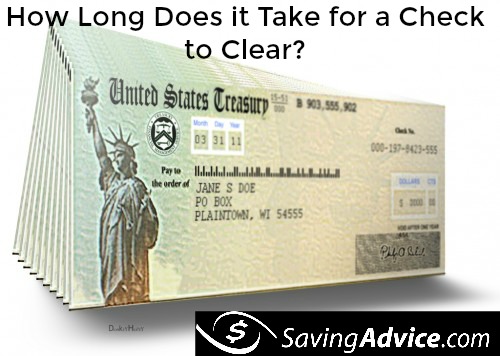 It would be nice it there was a standard answer to the questions, “How long does it take a check to clear?” which would be applicable to all banks, but unfortunately, this isn’t the case. Each bank sets the time that a check clears depending on the policies that they have implemented in order to confirm that a check is good. Since these policies vary from bank to bank, the time that it takes for a check to clear also varies from bank to bank.
It would be nice it there was a standard answer to the questions, “How long does it take a check to clear?” which would be applicable to all banks, but unfortunately, this isn’t the case. Each bank sets the time that a check clears depending on the policies that they have implemented in order to confirm that a check is good. Since these policies vary from bank to bank, the time that it takes for a check to clear also varies from bank to bank.
There are a number of reasons that it can be important to know how long it takes for a check to clear.
Urgent Need
There may be times when you need money for an emergency and are counting on the funds from a check to help out with it. When situations like this occur, there can be a huge difference between a check that clears the next day and one that takes several days to clear.
Money Management
It’s often important to know how much money you actually have in your account when making financial decisions. If you make a financial decision with the assumption that a check will clear in a certain amount of time and it doesn’t, this can cause an number of issues to arise that can cost you money.
Paycheck to Paycheck
Far too many people live paycheck to paycheck with no room for error when it comes to the funds in their bank account. If a check doesn’t clear before a bill comes due, the payment might not go through. In addition, there could be a variety of fees imposed that can make staying above water even more difficult for the person living paycheck to paycheck, especially if a check bounces because they thought the funds from a deposited check would be available before they actually cleared.
For the reasons above, it’s important for most people to understand how long their bank will take to clear a check. The first important step is to understand how to know how much you actually have in your account and how much is still waiting to clear.
When you get a receipt from your bank, it will usually have two numbers: the account balance and the available balance. The available balance is the amount in your account which you are able to spend. The account balance is all the funds that have been deposited into your account, including those checks that have been deposited, but not yet cleared. To figure out how much has not yet cleared, you can subtract the available balance form the account balance.
The reason that the funds aren’t available the moment that you deposit the check into your account is that the bank needs to make sure that the account from the check deposited has the available funds to be transferred into your account. it’s only after the bank can verify that the funds are there and they have been transferred into you account that they become available for you to use.
Again, since it depends on the verification policies of the particular bank, the amount of time it takes for them to confirm the amount is available and clear it as available funds to you will vary from bank to bank. Below you will find the amount of time you can expect a check to clear after you make the deposit from some of the more popular banks in the US:
Bank of America
Bank America will clear checks the same day they’re deposited when deposited before the cut-off time (this time varies and is posted at each branch). If the funds are deposited after the cut-off time, the check will clear the next business day.
Branch Banking and Trust (BB&T)
BB&T has a different set of rules for their own checks and checks from other institutions. Checks from BB&T checking accounts will clear the same day while checks from other institutions will be available the next business day.
Capital One
Capital One clears checks the next business day after the initial deposit as long as they are deposited before 2:00 PM local time. A check deposited after 2:00 PM will clear on the second business day after the deposit.
Chase
Chase will clear checks at midnight for checks deposited before 8:00 PM local time. A check deposited after 8:00 PM will clear at midnight on the following business day after the deposit.
Citibank
Citibank clears checks two to three business days after the check is initially deposited.
PNC Bank
PNC Bank has a different set of rules depending on the age of the bank account. For bank accounts less than 30 days old, the check will clear in two business days. For accounts older than 30 days, a check will clear the next business day.
SunTrust Bank
SunTrust Bank clears checks the next business day after the initial deposit as long as they are deposited before 4:00 PM local time. A check deposited after 4:00 PM will clear on the second business day after the deposit.
TD Bank
TD Bank clears checks the next business day after the initial deposit as long as they are deposited before 8:00 PM Eastern Standard Time. A check deposited after 8:00 PM will clear on the second business day after the deposit.
US Bank
US Bank has a different set of rules depending on the age of the bank account. For bank accounts less than 30 days old, the check may take up to five business days to cleat. For accounts older than 30 days, $200 will be available immediately upon deposit. If the check is for more than that, the remainder of the balance will clear the next business day.
Wells Fargo Bank
Wells Fargo Bank clears checks the next business day after the initial deposit.
The above is all information about how long a check will take to clear when you deposit a check from someone else into your banking account. The question of how long it will take for a check that you wrote to someone else to clear is dependent on their particular bank’s policies. It’s also important to remember that the bank won’t begin the clearing process until your check has been deposited. If the person you give the check to holds onto it and doesn’t take it to their bank, the clearing process won’t begin. This makes it much more difficult to predict when checks that you write will clear than when checks that you deposit will clear.
More From SavingAdvice.com
What Banks Are Open on Sunday?
Are Credit Unions Better Than Banks?
Best Banks for Student Loan Refinance
And if you’re in need of some amusement, the Federal Reserve has a neat write up on the life of a dollar bill.
(Photo courtesy of DonkeyHotey)
Read the full article here








